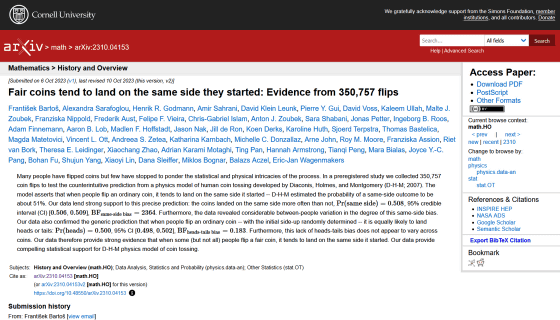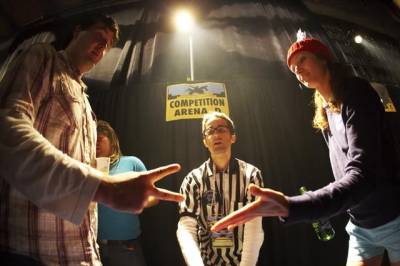Analysis of over 350,000 coin tosses reveals that coin tosses are not completely random, but have a slight bias in the direction in which they appear.

``Coin
Fair coins tend to land on the same side they started: Evidence from 350,757 flips
https://arxiv.org/abs/2310.04153

The Way You Flip a Coin Could Mean It's Not as Random as You'd Expect : ScienceAlert
https://www.sciencealert.com/the-way-you-flip-a-coin-could-mean-its-not-as-random-as-youd-expect
Coin tosses are used not only for everyday betting and play, but also in situations where the outcome can have a major impact, such as international sports matches and important corporate projects. Therefore, if there is a subtle bias in the result of a coin toss, it can have serious consequences.
Therefore, 48 members of an international research team acted as test subjects and filmed themselves tossing a coin over and over again using 46 different currencies. We then analyzed the results of a total of 350,757 coin tosses and investigated whether there was any bias in the side that came out.
As a result of the analysis, it was found that the coin toss was slightly more likely to come out on the side that was facing up before the coin was flipped. Specifically, out of 350,757 times, 178,078 times the side that was facing upward came out, which was a percentage of ``50.8%''. Even with different coins, there was a bias that ``the side that was initially pointing upwards is more likely to appear'', but there was no bias in terms of ``heads or tails''.

In fact, the theory that ``when tossing a coin, the side that was initially facing up is more likely to come out'' was proposed by mathematician
The research team said, ``Persi Dianicos proposed that when a person tosses a coin, a slight precession or wobble (change in the direction of the axis of rotation throughout the coin's trajectory) occurs, and the standard model for coin tossing is According to Dianicos' model, precession causes the coin to spend more time in the air with its initially upturned side facing up. , the coin is more likely to land on the same side it started with.”
In addition, it seems that the bias in coin tossing differed between researchers, and factors such as ``what form the person uses to toss the coin'' and ``whether or not to catch the coin in the air'' may also affect the results. It is said that there is a sex.

You might think that the result that ``coin flips are 50.8% more likely to turn up on the side that was initially facing up'' is not a big difference if you look at it from just one trial. However, in a game where two people bet 100 yen each and the person who guesses the side of the coin toss wins 200 yen, if one person continues to bet on the side that was initially facing up, then the average bet per 1000 times is This will result in a profit of 1900 yen. Also, if it is a coin toss in an important situation, many people would like to increase their winning rate even by just 0.8%.
The research team points out, ``Despite the widespread popularity of coin flips, few people stop and think, ``Maybe the outcome of a coin toss is not random.'' To prevent the bias we found from being exploited, we proposed that during important coin tosses, it would be better to hide the side facing up first.
The results of this research have not yet been published in a peer-reviewed journal, but are published on the preprint server arXiv.
Related Posts:
in Science, Posted by log1h_ik







